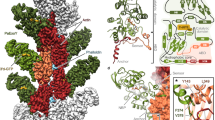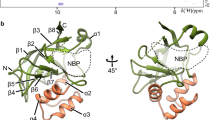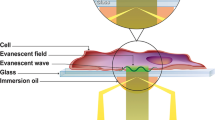Abstract
ADP-ribosylation of regulatory proteins is an important pathological mechanism by which various bacterial toxins affect eukary-otic cell functions. While diphtheria toxin catalyses the ADP-ribosylation of elongation factor 2, which results in inhibition of protein synthesis, cholera toxin and pertussis toxin ADP-ribosylate Ns and Ni respectively, the GTP-binding regulatory components of the adenylate cyclase system, thereby modulating the bidirectional hormonal regulation of the adenylate cyclase1,2Botulinum C2 toxin is another toxin which has been reported to possess ADP-ribosyltransferase activity3. This extremely toxic agent is produced by certain strains of Clostridium botulinum4 and induces hypotension5, an increase in intestinal secretion6 vascular permeability7 and haemorrhaging in the lungs5. In contrast to botulinum neurotoxins, the botulinum C2 toxin apparently lacks any neurotoxic effects5. Here we report that botulinum C2 toxin ADP-ribosylates a protein of relative molecular mass 43,000 (43K) in intact cells and in cell-free preparations. We present evidence that the 43K protein substrate is actin, which is apparently mono-AD P-ribosylated by the toxin. Botulinum C2 toxin also ADP-ribosylated purified liver G-actin, whereas liver F-actin was only poorly ADP-ribosylated and skeletal muscle actin was not ADP-ribosylated in either its G form or its F form. ADP-ribosylation of liver G-actin by botulinum C2 toxin resulted in a drastic reduction in viscosity of actin polymerized in vitro.
This is a preview of subscription content, access via your institution
Access options
Subscribe to this journal
Receive 51 print issues and online access
$199.00 per year
only $3.90 per issue
Buy this article
- Purchase on Springer Link
- Instant access to full article PDF
Prices may be subject to local taxes which are calculated during checkout
Similar content being viewed by others

References
Foster, J. W. & Kinney, D. M. CRC crit. Rev. Microbiol. 11, 273–297 (1985).
Gill, D. M. & Woolkalis, M. Ciba Fdn Symp. 112, 47–69 (1985).
Simpson, L. L. J. Pharmac. exp. Theor. 230, 665–669 (1984).
Ohishi, I., Iwasaki, M. & Sakaguchi, G. Infect. Immunity 30, 668–673 (1980).
Simpson, L. L. J. Pharmac. exp. Ther. 223, 695–701 (1982).
Ohishi, I. Infect. Immunity 40, 691–695 (1983).
Ohishi, I. Infect. Immunity 40, 336–339 (1983).
Simpson, L. L. Pharmac. Rev. 33, 155–188 (1981).
Wieland, T. Naturwissenschaften 64, 303–309 (1977).
Ohishi, I., Miyake, M., Ogura, H. & Nakamura, S. FEMS Microbiol. Lett. 23, 281–284 (1984).
Jakobs, K. H., Saur, W. & Schultz, G. Naunyn Schmiedeberg's Arch. Pharmac. 302, 285–291 (1978).
Laemmli, U. K. Nature 227, 680–685 (1970).
Jakobs, K. H., Gehring, U., Gaugler, B., Pfeuffer, T. & Schultz, G. Eur. J. Biochem. 130, 605–611 (1983).
Jaberg, B. Z. Naturforsch. 38c, 829–833 (1983).
Towbin, H., Staehelin, T. & Gordon, J. Proc. natn. Acad. Sci. U.S.A. 76, 4350–4354 (1979).
Pardee, J. D. & Spudich, J. A. Meth. Enzym. 85, 164–181 (1982).
Pollard, T. D. & Cooper, J. A. Meth. Enzym. 85, 211–230 (1982).
Author information
Authors and Affiliations
Rights and permissions
About this article
Cite this article
Aktories, K., Bärmann, M., Ohishi, I. et al. Botulinum C2 toxin ADP-ribosylates actin. Nature 322, 390–392 (1986). https://doi.org/10.1038/322390a0
Received:
Accepted:
Issue Date:
DOI: https://doi.org/10.1038/322390a0
This article is cited by
-
Preclinical characterization of the efficacy and safety of biologic N-001 as a novel pain analgesic for post-operative acute pain treatment
Scientific Reports (2023)
-
From signal transduction to protein toxins—a narrative review about milestones on the research route of C. difficile toxins
Naunyn-Schmiedeberg's Archives of Pharmacology (2023)
-
Golgi stress induces SIRT2 to counteract Shigella infection via defatty-acylation
Nature Communications (2022)
-
Intoxication of mammalian cells with binary clostridial enterotoxins is inhibited by the combination of pharmacological chaperone inhibitors
Naunyn-Schmiedeberg's Archives of Pharmacology (2021)
-
Intracellular G-actin targeting of peripheral sensory neurons by the multifunctional engineered protein C2C confers relief from inflammatory pain
Scientific Reports (2020)
Comments
By submitting a comment you agree to abide by our Terms and Community Guidelines. If you find something abusive or that does not comply with our terms or guidelines please flag it as inappropriate.


